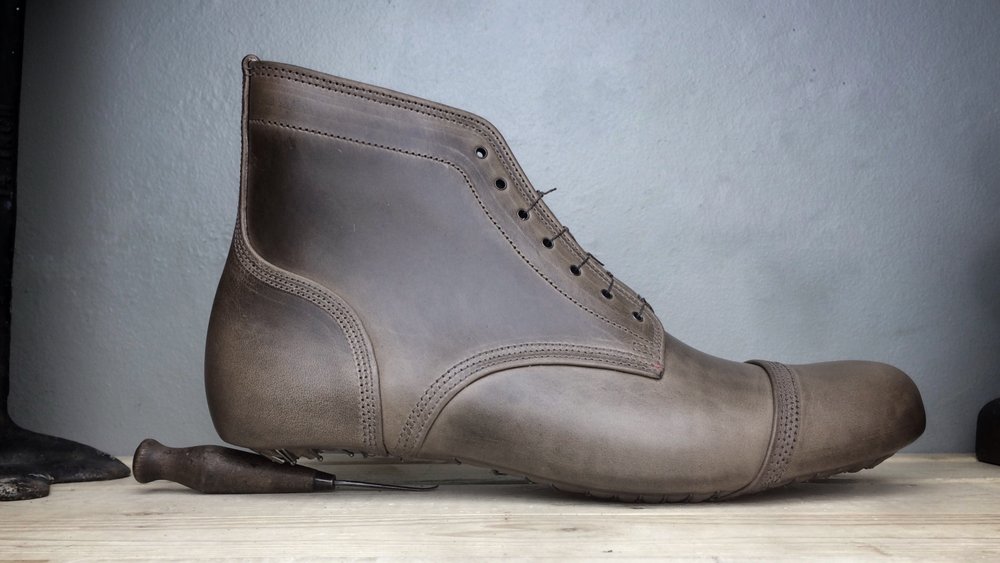NOTE: This section is still under construction and describes the overall process our hand-welted footwear goes through. Nailed construction is slightly different and there is a page on that in development (also under construction).
The Upper
"Clicking" is the process by which the hide is divided into individual pieces of leather, based on which sections of the hide are best suited for which sections of a boot or shoe. A pattern is used to cut the pieces to the precise shape and size required. The pieces are then thinned out (skived) on the edges as necessary, and then folded over to create a smooth edge that won't fray, and keep the water-shedding ability of the top "grain" intact. Additional reinforcement is added to any pieces than will experience additional stress, such as the top openings and the facings, where the lacing eyelets will be added later.
Following the upper leather, the lining is cut out and initial assembly is started, followed by the final "closing" of the upper. The basic process is to abrade the surfaces to be joined, glue them, and then stitch up to four rows of stitching to ensure a secure connection. All stitching is done with a single needle sewing machine.
Insole - the backbone of the shoe
With the upper completed, attention is turned to the foundation. In shoemaking terminology, an "insole" isn't the typical insert put in for comfort reasons. Rather, in a good pair of shoes, it's the piece of leather to which everything else is ultimately sewn. It's sometimes called the backbone of the shoe, and that's not a bad analogy. Thick, vegetable tanned leather is used for this step. The leather is hand selected for tightness of grain, split to a precise 5mm thickness, and wet molded to a last. Finally, a hold fast (leather “rib”) is carved in order to stitch through.
Using such a thick piece of leather helps to ensure a long life for the shoes, and because vegetable tanned leather is hydrophilic (moisture loving) by nature it is particularly well-suited to keep moisture levels under control while the shoe is being worn. Once this is done, lasting can begin.
Lasting
The process of stretching the upper part of the shoe over the "last" (the wood or plastic form around which the shoe is constructed) is called "lasting". While large factories have machines to do this (and basically every other step too) all Ryaton footwear is lasted by hand.
First the heel stiffener, another piece of vegetable tanned leather, is brushed with a specially prepared paste on both sides, and is inserted between the upper leather and lining leather at the heel. These layers are pressed into place and by a series of actions to get everything lined up correctly, the upper is placed over the last and the first "pulls" are taken.
On alternating sides, the upper is slowly pulled tightly over the last. Each pull is secured by driving a nail through the upper, stiffener, lining, and insole, and into the last. Care must be taken to ensure that everything is properly lined up, and that lasting is proceeding quickly enough to make all the necessary pulls before the paste sets. Once the sides and heel ("seat" in shoemaker speak) are lasted, a second stiffener called a "toe puff" is lasted and allowed to dry.
Once the toe puff has dried overnight, it is trimmed and rasped to the proper profile. At this point, the toe cap of the shoe is pulled back over and lasted as well. Once complete, the shoe is allowed to sit for about a week. This resting period ensures that the paste has time to dry completely and the leather has had time to adjust to its new shape. At this point, the welt can be sewn in.
Welting
A description of this process is being developed..!
I've run out of pictures! This will pick up with the next batch..
“Heavy in the hand, light on the foot.”



























